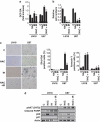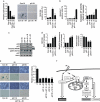PTEN status switches cell fate between premature senescence and apoptosis in glioma exposed to ionizing radiation
- PMID: 21072054
- PMCID: PMC3131905
- DOI: 10.1038/cdd.2010.139
PTEN status switches cell fate between premature senescence and apoptosis in glioma exposed to ionizing radiation
Abstract
Loss of the tumor suppressor phosphatase and tensin homolog (PTEN) has frequently been observed in human gliomas, conferring AKT activation and resistance to ionizing radiation (IR) and drug treatments. Recent reports have shown that PTEN loss or AKT activation induces premature senescence, but many details regarding this effect remain obscure. In this study, we tested whether the status of PTEN determined fate of the cell by examining PTEN-deficient U87, U251, and U373, and PTEN-proficient LN18 and LN428 glioma cells after exposure to IR. These cells exhibited different cellular responses, senescence or apoptosis, depending on the PTEN status. We further observed that PTEN-deficient U87 cells with high levels of both AKT activation and intracellular reactive oxygen species (ROS) underwent senescence, whereas PTEN-proficient LN18 cells entered apoptosis. ROS were indispensable for inducing senescence in PTEN-deficient cells, but not for apoptosis in PTEN-proficient cells. Furthermore, transfection with wild-type (wt) PTEN or AKT small interfering RNA induced a change from premature senescence to apoptosis and depletion of p53 or p21 prevented IR-induced premature senescence in U87 cells. Our data indicate that PTEN acts as a pivotal determinant of cell fate, regarding senescence and apoptosis in IR-exposed glioma cells. We conclude that premature senescence could have a compensatory role for apoptosis in the absence of the tumor suppressor PTEN through the AKT/ROS/p53/p21 signaling pathway.
© 2011 Macmillan Publishers Limited
Figures








References
-
- Hirose Y, Berger MS, Pieper RO. Abrogation of the Chk1-mediated G(2) checkpoint pathway potentiates temozolomide-induced toxicity in a p53-independent manner in human glioblastoma cells. Cancer Res. 2001;61:5843–5849. - PubMed
-
- Ohgaki H, Dessen P, Jourde B, Horstmann S, Nishikawa T, Di Patre PL, et al. Genetic pathways to glioblastoma: a population-based study. Cancer Res. 2004;64:6892–6899. - PubMed
-
- Keniry M, Parsons R. The role of PTEN signaling perturbations in cancer and in targeted therapy. Oncogene. 2008;27:5477–5485. - PubMed
Publication types
MeSH terms
Substances
LinkOut - more resources
Full Text Sources
Molecular Biology Databases
Research Materials
Miscellaneous

